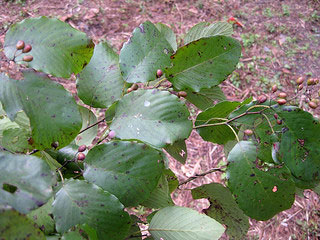Resource Library
Plant of the Week: Supple Jack Mulberry River
Supple Jack is a native vine with stout but flexible stems that can be used in handicraft projects much as rattan is used in the tropics.
Download High Resolution
Supple Jack Mulberry River
Latin: Berchemia scandens Rattan Vine
Gardens are a woven tapestry of plants with each filling a specific role. Vines are one of these plant groups that provide the weft for the tapestry and hold things together. However, being vines, and if not guided by the hands of a skilled weaver, they can overtake the garden. One of our native vines, Supple Jack or Rattan Vine (Berchemia scandens), has potential for use in the garden but its scheming little pea-brain also has world domination in mind.
Supple jack is a climbing member of the buckthorn family native in the woods throughout Arkansas, ranging from East Texas to Southern Missouri, east to Virginia and Florida. It is most often found in moist, rich streamside habitats where its smooth stems spiral in a counterclockwise fashion around trees and shrubs, eventually reaching the canopy height of the trees on which it grows. In the Ozarks it is sometimes seen in limestone glades where it sprawls across the ground creating a tangled groundcover.
Young stems are smooth and greenish with older vines becoming brownish in color and sometimes reaching 2 inches or more in diameter. The wood is tough and stringy, making it difficult to break. The spiraling, handmade canes favored by older gentlemen in the Ozarks are often made from the trunks of these vines. Leaves are 2 to 3 inches long, elliptical in outline with a pointed tip and wavy margins. The prominent veins arising from the leaf midrib are a distinguishing feature of the leaves, which are dark and shiny green above and lighter on the undersurface. The leaves persist into late fall and have a yellow-orange fall color.
Seldom noticed yellow-green, star-shaped flowers the diameter of a soda straw, are produced in May and June in open panicles amongst the foliage. In late summer, clusters of fleshy peanut sized fruit are produced which transition from green to blue and then mostly black as they age.
The berries are an important food source for wildlife. I once was asked to identify the seeds found in a pile of bear scat and found supple jack was one of the things he or she had been eating.
Supple jack is called rattan vine because the strong, pliable stems have reportedly been used as a substitute for rattan. True rattan is actually composed of the branches of several species of sprawling or climbing palms from Indonesia and adjacent islands. Though everyone cites the use of supple jack in basketry and weaving, I find no evidence on the Internet that it is a common practice.
It is native so it must be good, or so goes the logic of many. Well, being native is not enough to recommend a plant for inclusion in a garden setting. This is one vigorous vine and it is seldom used in gardens because it has the growth habit of a wisteria, except it doesn't have pretty flowers. If allowed to escape into the canopy of landscape trees, removal is time consuming and difficult.
There may be places where supple jack would be useful in a landscape setting. Such locations should be away from adjacent trees and self contained. For example, training supple jack over an arbor could provide quick cover and a safe place for an aggressive native plant. The birds would relish the berries but one would want to be vigilant to ensure that seedlings didn't emerge in unwanted areas.
Supple jack grows in sunny or shady sites in almost any soil. Though it favors moist, fertile sites it is quite drought tolerant. Based on its native range, it is only cold hardy to about minus 5 Fahrenheit, making it useful in zones 6 through 9.
By: Gerald Klingaman, retired
Retired Extension Horticulturist - Ornamentals
Extension News - February 14, 2014
